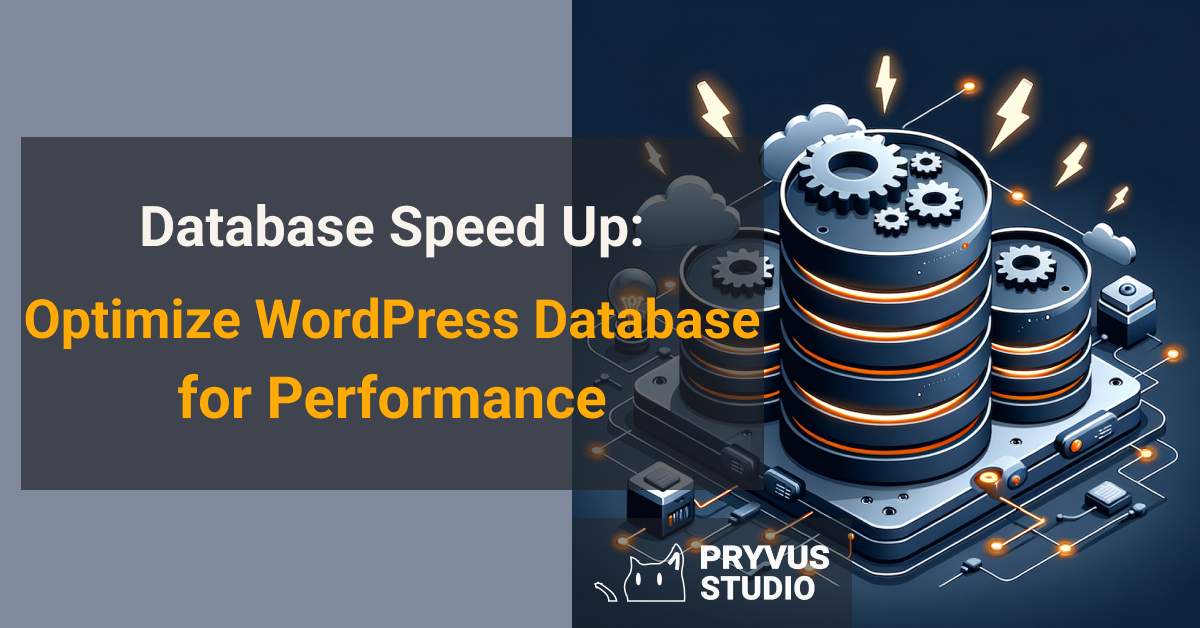Notice: Only variables should be passed by reference in /home/ploi/pryvus.com/public/wp-content/themes/pryvus/template-parts/content-post.php on line 12

Optimizing your WordPress database is crucial for site efficiency.
This process not only speeds up your site but also enhances user experience. It’s essential for maintaining a competitive edge in the digital world. In this article, you will learn:
- How to clean up unused data for a lean database
- Techniques to optimize database tables for speed
- Effective caching strategies for improved site performance
Understanding the Importance of Database Optimization
Ever wondered why your WordPress site starts to slow down over time? The culprit could often be found in the database. As your site grows, so does your database. This growth, while a sign of your site’s success, can lead to decreased performance if not managed properly. But fret not, as optimizing your WordPress database can significantly enhance your site’s speed and efficiency.
Optimizing your WordPress database is crucial for improving site performance and user experience.
A streamlined database ensures that your pages load faster, providing a better experience for your users. It also makes your site more manageable and easier to backup. The process involves cleaning up unnecessary data, optimizing table structures, and implementing caching solutions. By doing so, you can reduce server load, improve page loading times, and ultimately, enhance site performance.
Let’s dive into the specifics. Your WordPress database stores everything from posts and pages to comments, settings, and plugin information. Over time, it accumulates overhead, which is essentially clutter that can slow down your website. This clutter includes post revisions, trashed posts, spam comments, and unused tags and categories. By identifying and removing this unused data, you can significantly reduce your database size and improve query speeds.
Moreover, optimizing table structures and implementing advanced caching mechanisms can further boost your site’s performance. These steps ensure that your database runs as efficiently as possible, minimizing the time it takes to retrieve information and serve it to your users. Pryvus Studio, with its vast experience in custom software development, including innovative solutions in web and mobile development, emphasizes the importance of database optimization in streamlining processes and unlocking new opportunities for clients.
In conclusion, database optimization is not just a one-time task but a crucial part of your site’s ongoing maintenance. By regularly cleaning up your database and implementing optimization techniques, you can ensure that your WordPress site remains fast, efficient, and capable of growing without performance hitches.
Identifying and Cleaning Up Unused Data
When it comes to optimizing your WordPress database for performance, one of the first steps is to identify and clean up unused data. This includes spam comments, old drafts, unused tags, and stale metadata that can accumulate over time. Cleaning up this data can significantly reduce the size of your database, making it faster and more efficient.
The key to a swift WordPress database lies in regularly cleaning up unused data.

Start by checking your posts and pages for any drafts or revisions you no longer need. WordPress automatically saves multiple revisions of each post or page, which can quickly add up. Consider using a plugin that limits the number of revisions stored or manually delete old revisions.
Removing Spam Comments and Unused Tags
Spam comments and unused tags not only clutter your website but also your database. Regularly check your comments section and remove any spam. Additionally, go through your tags and categories, removing any that are no longer relevant to your content. This step not only cleans your database but also helps with site organization and SEO.
Optimizing Metadata and Cleaning Orphaned Data
Metadata associated with posts, such as tags and categories, can become orphaned if the posts are deleted. Use database optimization tools to identify and remove this orphaned metadata. Similarly, plugins and themes often leave behind data even after deletion. A thorough cleanup includes checking for and removing these remnants to ensure your database is lean and efficient.
By following these steps, you not only optimize your WordPress database for better performance but also enhance the overall functionality and user experience of your site. Remember, a clean database is a fast database.
Optimizing Your Database Tables for Speed
Once you’ve cleaned up unused data, the next step is optimizing your database tables. This is where the real speed gains happen. By fine-tuning the structure of your database, you can significantly reduce page load times. Let’s dive into how to make your WordPress database run like a well-oiled machine.
Optimizing database tables is a crucial step in enhancing your WordPress site’s performance.
First off, why is this important? Well, every time someone visits your site, WordPress runs queries against its database. If your tables are bloated or inefficiently structured, these queries take longer, slowing down your site. Here’s how to tackle it:
Checking Table Overhead
Start by checking the ‘overhead’ of your tables. Overhead refers to the extra space taken up by deleted rows. Tools like phpMyAdmin can show you this. If you notice significant overhead, it’s time for optimization.
Using Indexes Wisely
Indexes help your database find data faster. However, too many or poorly configured indexes can actually slow things down. Review your indexes and ensure they’re set up to aid your most common queries.
Choosing the Right Engine
Most WordPress sites use the MyISAM or InnoDB storage engines. InnoDB tends to be faster and more reliable, especially for sites that write data frequently. Consider converting to InnoDB if you haven’t already.
Defragmenting Tables
Over time, tables can become fragmented, especially after deleting a lot of data. Running an ‘OPTIMIZE TABLE’ command can defragment them, making data retrieval more efficient.
Remember, while these steps can significantly improve performance, they’re not a one-time fix. Regular maintenance is key to keeping your WordPress database speedy. And if you’re not comfortable performing these optimizations yourself, Pryvus Studios expertise in custom software and web development can help. Our focus on technology to solve business challenges includes ensuring your WordPress site runs at peak efficiency.
Implementing these strategies will not only speed up your site but also enhance the user experience, leading to increased satisfaction and potentially higher conversion rates. It’s a win-win!
Implementing Caching for Enhanced Performance
When it comes to speeding up your WordPress site, caching is a game-changer. It stores a version of your site’s pages and posts as static files. When visitors access your site, these files are served up quickly, reducing the need to fetch data from the database each time. This significantly cuts down on page loading times, improving both user experience and SEO rankings.
Caching transforms your WordPress site’s speed and efficiency by serving static versions of content to your visitors.

There are several types of caching you can implement: page caching, database caching, object caching, and browser caching. Each plays a unique role in enhancing your site’s performance. Page caching stores static versions of pages that don’t change often. Database caching speeds up database queries by saving the results for a set period. Object caching helps with speeding up dynamic elements, and browser caching stores files locally in the user’s browser for faster loading on repeat visits.
Choosing the Right Caching Solution
Not all caching solutions are created equal. It’s important to choose one that fits your site’s specific needs. Popular plugins like WP Super Cache, W3 Total Cache, and WP Rocket offer various caching functionalities tailored to different types of websites. Consulting with experts like Pryvus Studio can help you select the best option, ensuring optimal site performance.
Implementing Caching Step-by-Step
Implementing caching doesn’t have to be complicated. Most caching plugins come with easy-to-follow instructions. The key steps include installing the plugin, configuring caching settings, and testing your site’s performance before and after to see the improvements. Regularly clearing the cache after updates to your site ensures visitors see the most recent version of your content.
Remember, while caching is powerful, it’s just one part of a comprehensive strategy to optimize your WordPress database for performance. Regular updates, cleaning up unused data, and optimizing database tables are also crucial for maintaining a fast, efficient site.
Regular Maintenance and Monitoring for Long-Term Efficiency
Once you’ve optimized your WordPress database, it’s vital to keep it that way. Regular maintenance and monitoring are the keys to long-term efficiency. This not just keeps your site running smoothly but also prevents potential issues before they affect your site’s performance.
Consistent maintenance and vigilant monitoring are the cornerstones of a high-performing WordPress site.
Why is ongoing maintenance essential? Over time, your website accumulates data some of it necessary, some not. Without regular clean-ups, this can bog down your database, leading to slower page loads and a poor user experience. Here’s how to stay on top of it:
- Weekly checks: Review your site for spam comments, unused tags, and outdated content. Delete what’s not needed.
- Monthly reviews: Analyze your database’s performance. Look for tables that can be optimized or data that can be archived.
- Performance monitoring: Use tools to monitor your site’s speed and efficiency. Identify any slowdowns and address them promptly.
Remember, a well-maintained database is a fast database. By implementing a regular maintenance schedule, you can ensure your WordPress site remains efficient and effective, providing a superior experience for your users.
Moreover, monitoring tools can alert you to issues in real-time, allowing for quick fixes. This proactive approach minimizes downtime and keeps your site at peak performance.
In conclusion, while database optimization is a crucial step in improving your WordPress site’s performance, regular maintenance and monitoring ensure these improvements are sustained over time. Partnering with experts like Pryvus Studio, who understand the nuances of WordPress development, can provide peace of mind and guarantee your site remains fast, secure, and user-friendly.
Elevating Your WordPress Site’s Performance
Boosting your WordPress site’s performance is not just a goal; it’s a necessity in today’s fast-paced digital landscape. Optimizing your database plays a pivotal role in this journey, ensuring that your site runs efficiently and remains competitive. Here’s how you can take your site’s performance to the next level:
- Regular Cleanup: Schedule routine cleanups to remove spam, unused data, and orphaned metadata. This keeps your database lean and fast.
- Table Optimization: Regularly check and optimize your database tables. This includes defragmenting tables and using indexes efficiently to speed up query processing.
- Implement Caching: Choose the right caching solution for your site. Proper caching reduces page load times significantly, enhancing user experience.
- Performance Monitoring: Use monitoring tools to track your sites performance. Regular checks help identify and fix issues promptly.
Partnering with experts like Pryvus Studio can provide you with the insights and support needed to maintain and improve your WordPress sites performance. They offer professional advice and assistance, ensuring that your site is optimized, secure, and ready to meet the demands of your audience.
Ready to boost your site’s performance? Contact Pryvus Studio today and take the first step towards a faster, more efficient WordPress site. Elevate your sites performance and unlock new opportunities for growth and success.


